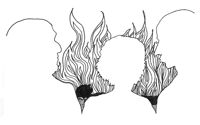STRANGE BUT TRUE- Cremation station: How to burn bodies for science

DRAWING BY DEBORAH DERR McCLINTOCK
Q. The fire spread across the man's bed and began consuming his nightclothes, then his body. Several people were close enough to help but no one lifted a hand. Why the callous indifference? –C. Stuart
A. It was actually calculated forensic research by a team of fire and death investigators, led by specialist Elayne Pope. Their mission: to determine exactly how the human body burns in a range of different circumstances, whether in house or car fires, from arson or murders where attempts are made to destroy the evidence, says Linda Geddes in New Scientist magazine. The "victims" in these cases actually died a while ago and had donated their bodies to medical science.
The million-dollar question is often whether a fire death was accidental or deliberate, and this is where Pope and her team come in. To date, they have made use of about 30 whole corpses and various additional body parts. (In the past, pig corpses were primarily utilized.) Pope's team has showed that, in the case of foul play where someone is shot or stabbed, the wound tends to open up during the fire and leave tell-tale burned-out regions.
The team also looked into a number of common fire-death myths, such as that of the exploding skull. Here they systematically burned 40 human heads before concluding that the brain may indeed boil, but there's no skull explosion– yet it may appear so once heat weakens it and falling debris crushes it. One of Pope's hopes for the future is for fire investigation to become more evidence based, as old textbook dogmas and myths are finally put to rest.
Q. It's not often that an invention or innovation has the effect of rescuing a single typewriter key from virtual oblivion, causing it to be pushed again and again. What is this key keyboard key? –G. Friday
A. The @ symbol, of course, which e-mail originator Ray Tomlinson in 1971 decided to use to link the user's name with the host network, "reviving this rather esoteric symbol and saving it from the brink of linguistic extinction," says Jack Challoner in 1001 Inventions that Changed the World. Unaware of the global significance of the 200 lines of code making up the e-mail program, Tomlinson allegedly neglected to note what he wrote in the first e-mail ever sent. Later, he said it was probably something banal like "QWERTYUIOP" or "testing 1 2 3 4."
Q. Your modest sloop "Puddleduck" is in harbor one calm evening as you entertain a lady friend on board. You're pouring a glass of red wine when suddenly a large cruiser sails silently by. Can you guess what happens next? –A. Onassis
A. The cruiser's wake hits "Puddleduck" on the beam, spilling wine over your lady friend, details Mark Denny in Float Your Boat! The Evolution and Science of Sailing.
She is about to remonstrate about her ruined white dress when the next wave hits, tipping her onto the floor and you on top of her. "Inappropriate behavior," she is about to shout when the next wave rattles you both around the deck like two peas in a can. She is set to leave when the next wave tips her overboard.
As she shrieks for help and splashes frantically, your thoughts turn naturally to the wave phenomenon of resonance: a series of broadside waves can instigate rolling behavior that is much more violent than a single wave. It is like the classic wine glass shattered by a diva's voice, but only if the pitch (resonance) is just so.
(At this point, "You dive in, rescue lady friend, send her tearfully home in a cab, and return to thinking about wave resonance.")
~
Send Strange questions to brothers Bill and Rich at [email protected].
#